Tanzanian seed company holds field days to popularize drought tolerant maize varieties

Yield is one of the key things farmers consider when deciding what seed to buy. Farmers in Arusha, Tanzania shared this fact during a field day held by Suba Agro Trading & Engineering Company. The seed company held two field days in June in Arusha and Moshi to give farmers the chance to examine new drought tolerant maize hybrids, TZH536 and TZH538, in the field.
Farmers often get information on what variety to plant based on what they observe doing well in fields in their locale, the advice they receive from other farmers, and the information they receive from the agrovets they buy seed from. About 30 farmers drawn from the Arusha, Kilimanjaro and Moshi districts attended the Moshi field day, as well as local agricultural extension workers and civic leaders from the area. The meeting was held just in front of the field by the roadside, so as the discussions were going on, farmers were able to see the maize being referred to. The maize was labeled and Suba Agro field staff also cut some plants and exposed the cobs for the farmers to see their yield potential.
In Arusha, the field day was held on a Saturday which was market day. Many people popped in to learn about the new maize varieties before returning to the market to buy or sell wares. “Comparing what I see on this [demonstration] field with what is on the neighboring plot, I can see it is drought tolerant,” said Mariamu Hemedi, a local farmer. “We can see that it has not been watered—there is no tap or well here but the maize has thrived. Now we want to know how it is when it is shelled,” Hemedi added. As participants walked through the field examining the cobs, Sarah Muya, an administrator and assistant to the managing director at Suba Agro encouraged them to taste the grains from the green cobs. “It has a good taste,” she said while offering a cob to taste.
Farmers identified the double cobbing in TZH538 as a key feature they liked because it demonstrated they would get higher yields. “When farmers get good yields, it contributes to development as the extra money gained from selling surplus grain contributes to other development initiatives,” said Eliahidi Mvambi, another farmer. W. S. Chonya, the company’s product development manager, told farmers to buy seed early to be prepared for the rain. Muya advised farmers to ensure they buy certified seed and keep receipts of all their seed purchases to enable them trace the source of ‘bad’ seed. “Take up farming as a business,” Muya said, advising farmers to invest in inputs such as improved seed and fertilizer.
Rose E. Moshi, the ward agricultural extension officer, spoke at the event and urged the seed company to ensure the new seed varieties were distributed in the area before the start of the planting season. “Sometimes farmers identify good seed but when they go to the shops, it is unavailable,” Moshi said. She also spoke on the importance of seed purity, citing it as one of the key challenges farmers face. Chonya then explained the features on Suba Agro seed packets to the farmers, highlighting the quality of the paper and the Tanzanian flag at the top of the pack to help farmers identify and avoid counterfeit seed. “Now that you have seen how this seed performs in a farmer’s field, we request you to be our ambassadors in your villages,” Chonya said. The company is in the process of multiplying the seed for these varieties in preparation for the next planting season. The company also participated in agricultural shows in August in Arusha, Mbeya and Morogoro to give more farmers information about its products.
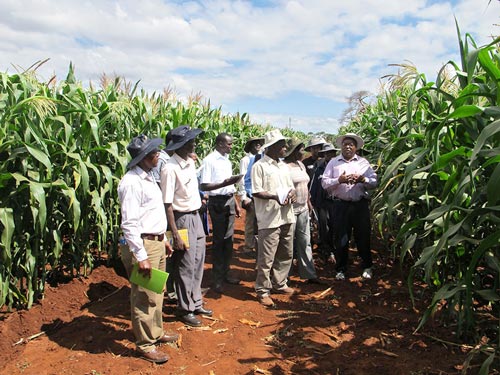 “The trip was an eye opener for me. We have no mass rearing facility in Ethiopia; neither do we practice artificial infestation of stem borers. We only undertake natural infestation for our trials, which does not give uniform infestation, leading us to wrong conclusions,” said Midekssa Ardessa from Bako Agricultural Research Center at the Ethiopian Institute of Agricultural Research (EIAR), who visited CIMMYT-Kenya during 21-27 July 2013 with a team of scientists from Ethiopia, Uganda, Tanzania, and Mozambique, to gain hands-on experience in breeding insect-resistant maize. “We are now very knowledgeable on mass rearing of stem borers and on running an insectary after our visit and practical sessions at the CIMMYT Katumani Insectary,” added Abiy Dibaba from EIAR’s Melkasa Agricultural Research Center. “At the CIMMYT Kiboko Postharvest Lab, we learned a lot about maize weevils and the larger grain borer, and how to screen maize for resistance against these postharvest pests.”
“The trip was an eye opener for me. We have no mass rearing facility in Ethiopia; neither do we practice artificial infestation of stem borers. We only undertake natural infestation for our trials, which does not give uniform infestation, leading us to wrong conclusions,” said Midekssa Ardessa from Bako Agricultural Research Center at the Ethiopian Institute of Agricultural Research (EIAR), who visited CIMMYT-Kenya during 21-27 July 2013 with a team of scientists from Ethiopia, Uganda, Tanzania, and Mozambique, to gain hands-on experience in breeding insect-resistant maize. “We are now very knowledgeable on mass rearing of stem borers and on running an insectary after our visit and practical sessions at the CIMMYT Katumani Insectary,” added Abiy Dibaba from EIAR’s Melkasa Agricultural Research Center. “At the CIMMYT Kiboko Postharvest Lab, we learned a lot about maize weevils and the larger grain borer, and how to screen maize for resistance against these postharvest pests.”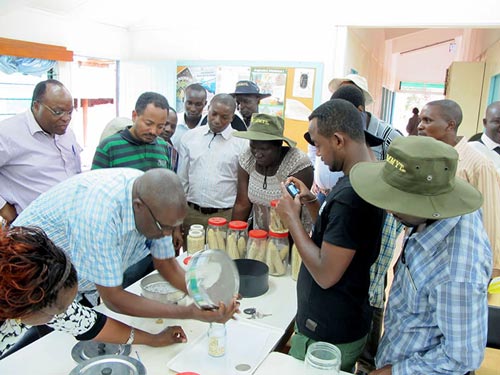 The annual IRMA project’s program has trained more than 50 scientists since its inception in 2009. “Most of us talk very easily and confidently about insect rearing. However, it is quite a challenge when we engage in the practical aspects,” said Tefera. “What we have exposed you to is just a tip of the iceberg in the business of mass rearing of insects. There is still a lot to learn, much of it by yourself as you engage in the practical aspects of it.” The participants appreciated the effort taken by the organizers. One of them, Egas Nhamucho of IIAM, said: “Infestation of maize with stem borers was a real learning point for me, a real delicate task of picking out very tiny 10 insect larvae, ensuring that you do not pierce and kill them with the camel brush, and carefully and strategically placing them on each maize plant. The practical sessions really made me appreciate some of the tasks we have always taken for granted.”
The annual IRMA project’s program has trained more than 50 scientists since its inception in 2009. “Most of us talk very easily and confidently about insect rearing. However, it is quite a challenge when we engage in the practical aspects,” said Tefera. “What we have exposed you to is just a tip of the iceberg in the business of mass rearing of insects. There is still a lot to learn, much of it by yourself as you engage in the practical aspects of it.” The participants appreciated the effort taken by the organizers. One of them, Egas Nhamucho of IIAM, said: “Infestation of maize with stem borers was a real learning point for me, a real delicate task of picking out very tiny 10 insect larvae, ensuring that you do not pierce and kill them with the camel brush, and carefully and strategically placing them on each maize plant. The practical sessions really made me appreciate some of the tasks we have always taken for granted.”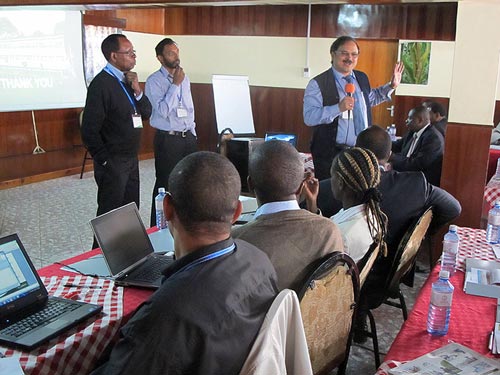 “I can now identify with accuracy plants affected with maize lethal necrotic disease,” stated Regina Tende, PhD student attached to CIMMYT, after attending the CIMMYT-Kenya Agricultural Research Institute (
“I can now identify with accuracy plants affected with maize lethal necrotic disease,” stated Regina Tende, PhD student attached to CIMMYT, after attending the CIMMYT-Kenya Agricultural Research Institute (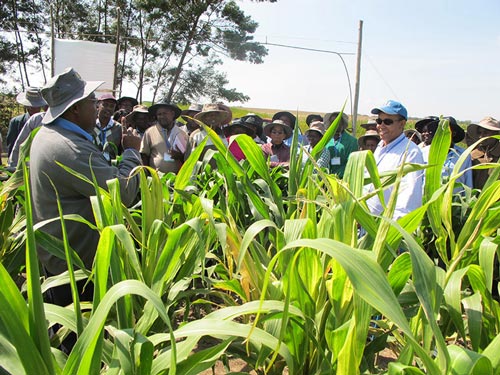 During his opening speech, Joseph Ng’etich, deputy director of Crop Protection, Ministry of Agriculture, noted that about 26,000 hectares of maize in Kenya were affected in 2012, resulting in an estimated loss of 56,730 tons, valued at approximately US$ 23.5 million. Seed producers also lost significant acreages of pre-basic seed in 2012: Agriseed lost 10 acres in Narok; Kenya Seed lost 75; and Monsanto 20 at Migtyo farm in Baringo, according to Dickson Ligeyo, KARI senior research officer and head of Maize Working Group in Kenya.
During his opening speech, Joseph Ng’etich, deputy director of Crop Protection, Ministry of Agriculture, noted that about 26,000 hectares of maize in Kenya were affected in 2012, resulting in an estimated loss of 56,730 tons, valued at approximately US$ 23.5 million. Seed producers also lost significant acreages of pre-basic seed in 2012: Agriseed lost 10 acres in Narok; Kenya Seed lost 75; and Monsanto 20 at Migtyo farm in Baringo, according to Dickson Ligeyo, KARI senior research officer and head of Maize Working Group in Kenya.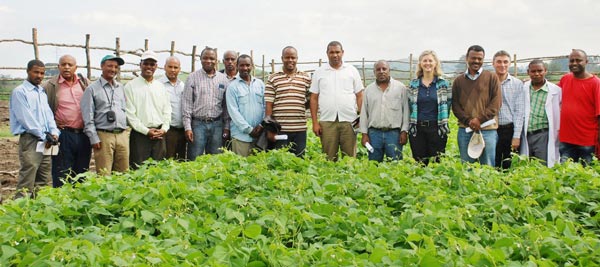 Myths and cultural practices can block farmers’ acceptance of a new technology, particularly the principles of reduced tillage, residue retention, and cropping rotations that underlie conservation agriculture. This was one observation in a recent visit to farmers in four districts in Ethiopia by Australian International Food Security Centre (
Myths and cultural practices can block farmers’ acceptance of a new technology, particularly the principles of reduced tillage, residue retention, and cropping rotations that underlie conservation agriculture. This was one observation in a recent visit to farmers in four districts in Ethiopia by Australian International Food Security Centre (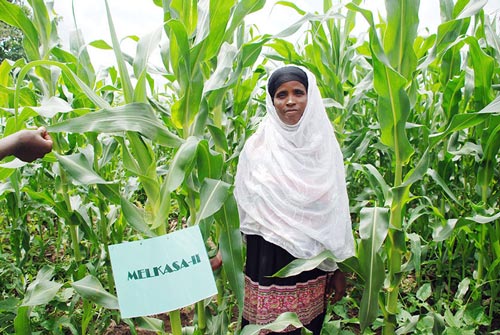
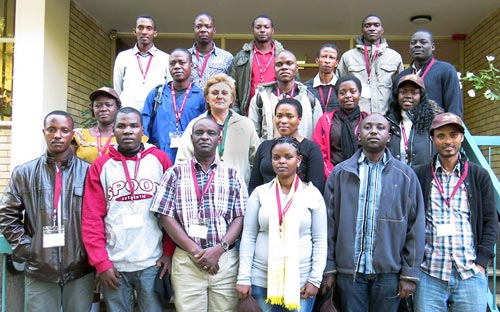 Fifteen young scientists from
Fifteen young scientists from 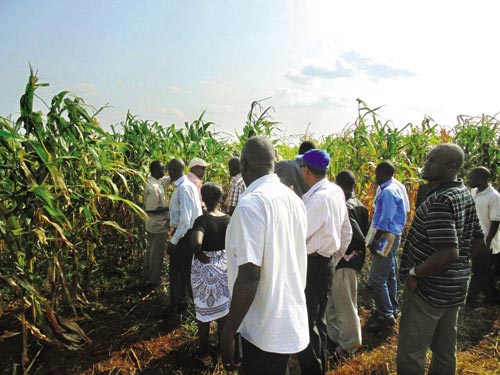
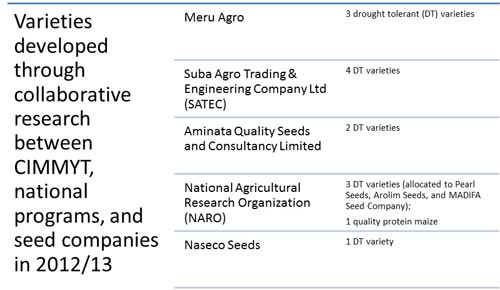
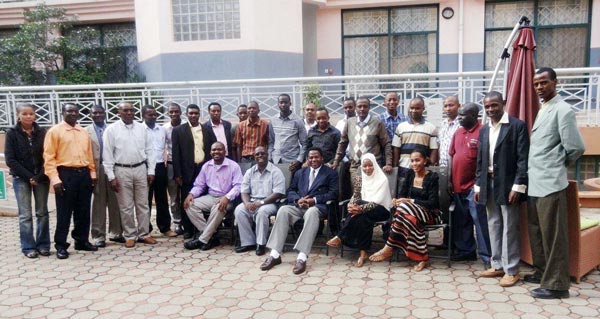
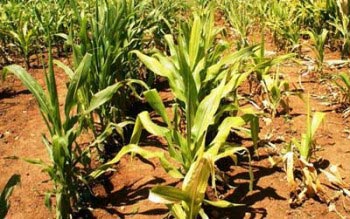 The maize lethal necrosis (MLN) disease first appeared in Kenya’s Rift Valley in 2011 and quickly spread to other parts of Kenya, as well as to Uganda and Tanzania. Caused by a synergistic interplay of maize chlorotic mottle virus (MCMV) and any of the cereal viruses in the family, Potyviridae, such as Sugarcane mosaic virus (SCMV), Maize dwarf mosaic virus (MDMV), or Wheat streak mosaic virus (WSMV), MLN can cause total crop loss if not controlled effectively.
The maize lethal necrosis (MLN) disease first appeared in Kenya’s Rift Valley in 2011 and quickly spread to other parts of Kenya, as well as to Uganda and Tanzania. Caused by a synergistic interplay of maize chlorotic mottle virus (MCMV) and any of the cereal viruses in the family, Potyviridae, such as Sugarcane mosaic virus (SCMV), Maize dwarf mosaic virus (MDMV), or Wheat streak mosaic virus (WSMV), MLN can cause total crop loss if not controlled effectively.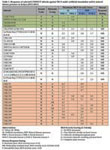
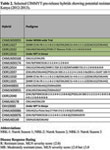
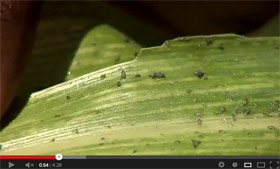
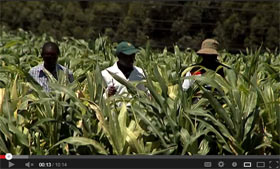
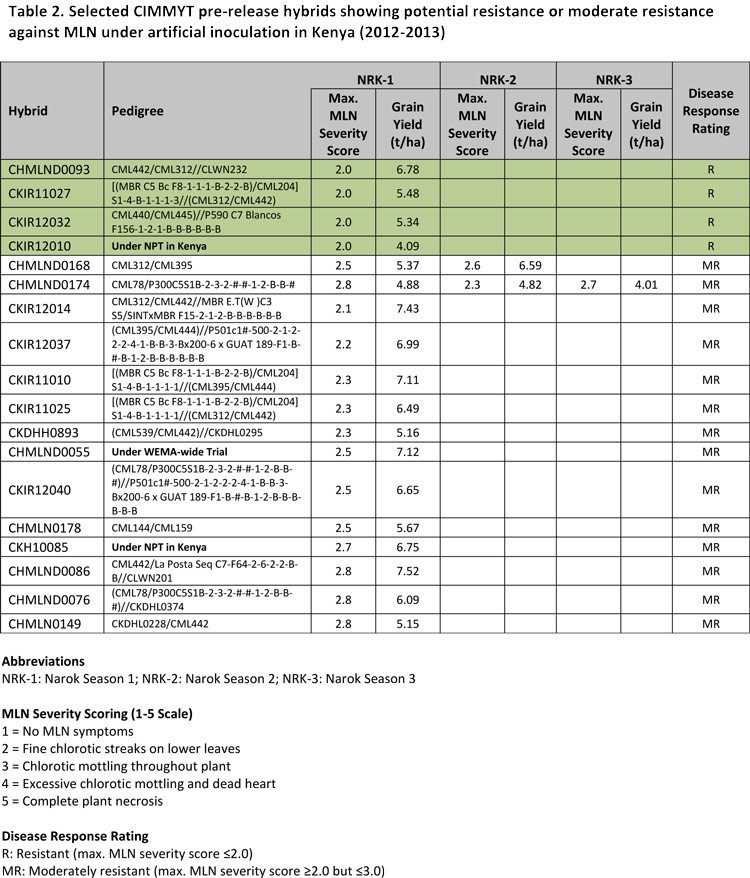 Download table in pdf format
Download table in pdf format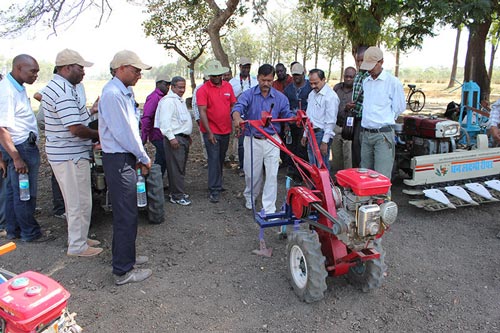 From 29 April to 10 May, 16 agricultural engineers, agronomists, machinery importers, and machinery manufacturers from Ethiopia, Kenya, Tanzania, and Zimbabwe took part in a study tour in India organized by CIMMYT, the Indian Council of Agricultural Research (
From 29 April to 10 May, 16 agricultural engineers, agronomists, machinery importers, and machinery manufacturers from Ethiopia, Kenya, Tanzania, and Zimbabwe took part in a study tour in India organized by CIMMYT, the Indian Council of Agricultural Research (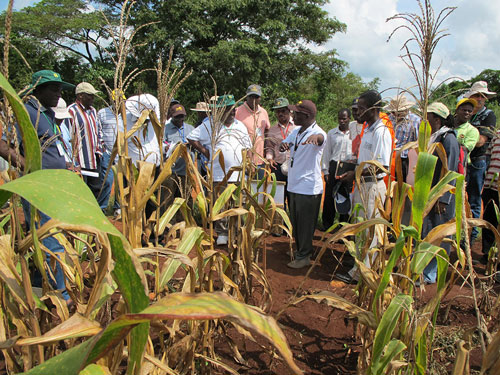 Over 200 researchers, policy makers, donors, seed companies, and NGO representatives from Africa and Australia gathered in Chimoio, Mozambique, during 17-23 March 2013 for the third
Over 200 researchers, policy makers, donors, seed companies, and NGO representatives from Africa and Australia gathered in Chimoio, Mozambique, during 17-23 March 2013 for the third 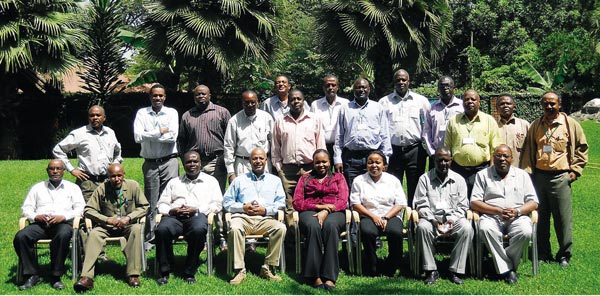
 A recently-emerged disease in Eastern Africa, maize lethal necrosis (
A recently-emerged disease in Eastern Africa, maize lethal necrosis (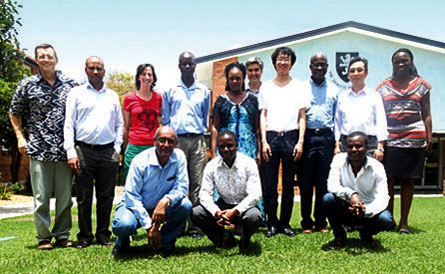
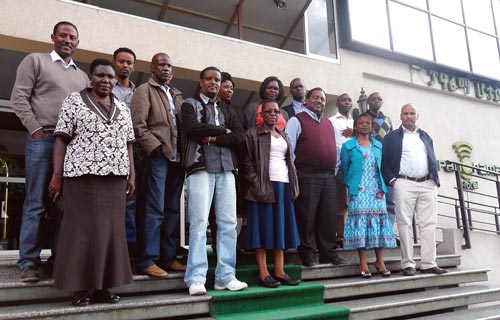 Understanding the value chain of maize and legume crops and the ability to define various actors as well as their contributions and constraints along the value chain is crucial in identifying feasible interventions. Since these activities fall within the scope of the
Understanding the value chain of maize and legume crops and the ability to define various actors as well as their contributions and constraints along the value chain is crucial in identifying feasible interventions. Since these activities fall within the scope of the 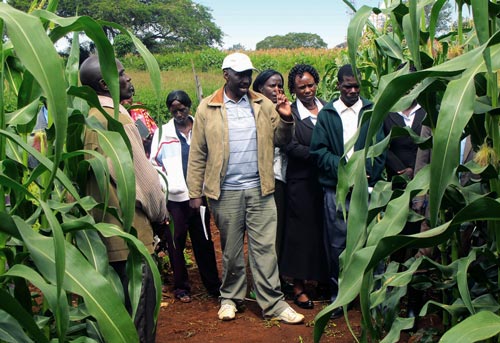 Gender mainstreaming in agricultural development is on the agenda of national governments and the international development community (for more information on CIMMYT and gender mainstreaming see “
Gender mainstreaming in agricultural development is on the agenda of national governments and the international development community (for more information on CIMMYT and gender mainstreaming see “